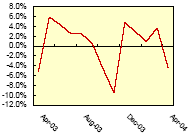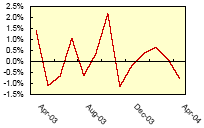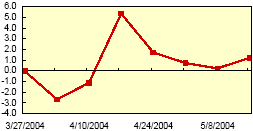



Poultry Outlook Report - May 2004
By U.S.D.A., Economic Research Service - This article is an extract from the May 2004: Livestock, Dairy and Poultry Outlook Report, highlighting Global Poultry Industry data. The report indicates that lower red meat production is more than offset by larger poultry production. NOTE: This issue presents the first projections of U.S. livestock and poultry product
supply, use, and prices for 2005. Due to uncertainties as to the length of bans regarding
the imports of ruminant products because of the discovery of a BSE-infected cow in
December 2003, forecasts for 2004 and 2005 assume a continuation of policies currently
in place. Subsequent forecasts will reflect any announced changes.
NOTE: This issue presents the first projections of U.S. livestock and poultry product
supply, use, and prices for 2005. Due to uncertainties as to the length of bans regarding
the imports of ruminant products because of the discovery of a BSE-infected cow in
December 2003, forecasts for 2004 and 2005 assume a continuation of policies currently
in place. Subsequent forecasts will reflect any announced changes.
|
Retail Turkey Price
Percent change from previous month 
|
In 2004, table egg production is expected to increase 1.6 percent due to the buildup of the laying flocks. Wholesale prices will most likely average 95-100 cents per dozen reflecting record first-quarter levels and strong demand for animal protein foods. In 2003, prices averaged 88 cents per dozen. For 2005, wholesale table egg prices (NY grade A) are forecast to average 91-99 cents per dozen, reflecting an expected 1.4 percent increase in table egg production.
Broiler Production Higher, Turkey Production Lower in First-Quarter 2004
|
Composite Broiler Price
Percent change from previous month 
|
Broiler production for the second quarter is forecast at 8.56 billion pounds, an increase of 3.5 percent from last year. During April, the daily broiler slaughter numbers reported by the Agricultural Marketing Service indicated a production increase of around 3.5 percent from the same period a year earlier. Most of the gain was from higher average bird weights. Other indicators pointing to higher future production are the weekly increases in the number of chicks placed for growout. Over the last 5 weeks (through May 1) the number of chicks being placed for growout has averaged just around 2 percent higher than in the same period in 2003. With strong prices forecast to continue through the remainder of 2004, broiler production is expected to expand again in 2005 to 35.1 billion pounds, slightly over 3 percent higher than a year earlier.
Turkey production totaled 1.3 billion pounds in first-quarter 2004, down 5.6 percent from the previous year. The situation with turkey production is the opposite from broilers, with the overall number of birds being slaughtered down and with average weights also lower. Over the last 15 months (January 2003 through March 2004) the number of poults being placed for growout has been almost continuously below the level for the same month in the previous year. Turkey production in 2004 is now estimated at 5.44 billion pounds, 3.7 percent below 2003. However, increased prices and moderating feed costs are expected to encourage producers to increase production in 2005. Production is forecast at 5.58 billion pounds, 2.4 percent higher than in 2004 and about even with production in 2001.
Broiler and Turkey Stocks Lower
|
Weekly Broiler Slaughter
Percent change from last year 
|
Ending turkey stocks for the first quarter of 2003 were 515 million pounds, 6.2 percent lower than the previous year. There was a wide difference in the stock levels for whole birds and parts. Stocks of whole birds were up 10 percent from the previous year, while stocks of turkey parts totaled 254 million pounds, down 19 percent from the end of the first quarter of 2003. Stock levels for whole birds were higher at the end of the first quarter, compared with the previous year. However, wholesale prices for whole birds (toms and hens) averaged 60.6 cents per pound in the first quarter of 2004, up 2 percent. First-quarter prices for most turkey parts were considerably stronger than during the same period in 2003. For example boneless/skinless breast meat was over 40 percent higher in the first quarter, and drumsticks were up over 100 percent.
Broiler Export Forecast Lowered for 2004
The broiler export forecast for 2004 has been reduced to 4.6 billion pounds, a reduction of 355 million pounds. The reduction is the result of continued restrictions on U.S. exports to a number of countries and the export dampening effect of much stronger prices for almost all broiler products. Broiler exports during the first quarter of 2004 were 1.02 billion pounds, nearly 15 percent from the previous year. Most of the decline was due to reduced shipments to Russia, China, and Japan resulting from bans on shipments because of earlier Avian Influenza outbreaks. The decline in exports to these countries was partially offset by higher shipments to countries such as Mexico, Canada, and Turkey. Exports in 2005 are expected to strengthen, reaching 4.9 billion pounds, close to the level exported in 2003.
Egg Prices Sharply Higher
|
Weekly Turkey Slaughter
Percent change from last year 
|
However, wholesale prices broke sharply from 122.9 cents in March to only 88.9 cents per dozen in April, partially reflecting the post-Easter price decline. The sharp price decline combined with rising feed costs (corn and soybean meal prices) has dramatically squeezed producers’ returns. In second-half 2003, egg prices and margins above feed costs rose rapidly, encouraging short-term adjustments (increased molting and delayed culling) to boost table egg production. As a result, egg production in the fourth-quarter 2003 was record high. Producers began expanding their layer flocks in response to the higher returns, as a result table egg production in the first quarter increased about 2 percent over a year ago. On April 1, 2004, U.S. egg-type layers totaled 282.8 million birds, an increase of nearly 2.2 million birds over a month earlier and the largest April inventory of egg-type layers since November 2002.
In 2004, table egg production is expected to increase about 1.7 percent due to the buildup of the laying flocks. Wholesale prices will likely average 95-100 cents per dozen, reflecting record firstquarter price and strong demand for protein foods. In 2003, prices averaged 88 cents per dozen. For 2005, wholesale table egg prices (NY grade A) are forecast to average 91-99 cents per dozen, reflecting a 1.4-percent increase in table egg production.
Likewise, retail egg prices averaged $1.59 per dozen in the first quarter of 2004, but are forecast to decline from the record levels. For all of 2004, retail egg prices are expected to average in the mid- $1.40s per dozen, which would be a record high. Retail egg prices in 2005 are expected to be about unchanged.
For all of 2004, due to the higher shell egg prices, the quantity of eggs going to the breaking market is expected to increase by nearly 2 percent above 2003. This trend will most likely continue and rise by about 1 percent in 2005, as prices are expected to stay about the same.
Total U.S. egg production in 2004, table and hatching, is expected to rise to nearly 7.39 billion dozen, or 1.6 percent, over 2003. Table eggs are expected to account for about 85 percent of total production in 2004, and likely will stay at the same percentage in 2005. Hatching egg production in 2004 is expected to rise by 1 percent, reflecting higher broiler production.
U.S. egg exports in 2004 are expected to reach 110 million dozen, down 25 percent from the previous year. The decline is mainly due to outbreaks of Avian Influenza in early 2004 and restrictions imposed by many countries on U.S. eggs and egg products. Shell eggs (for human consumption and hatching purposes) are more vulnerable to disease transmission, while processed egg products (yolks, egg albumen, dried or in liquid forms) are less likely capable of transmitting diseases. This situation will most likely last for several months, and exports are expected to rebound some in 2005.
Links
For more information view the full Livestock, Dairy and Poultry Outlook - May 2004 (pdf)Source: Livestock, Dairy and Poultry Outlook - U.S. Department of Agriculture, Economic Research Service - May 2004








